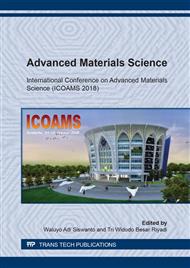p.91
p.97
p.107
p.112
p.118
p.126
p.137
p.148
p.156
Graphite as Dry Lubricant to Reduce Rail Wheels Wear Level
Abstract:
Wear occurs in rail wheels due to varying surface contact between wheel and railway. Many materials are used to minimize the wear effect of friction, one of which is graphite. Graphite has been known having dry lubricating ability. To find out the effect of graphite lubrication on wear level of wheel and railway, an experiment-based research is important to conduct. This research started with designing the construction of disc-on-disc wear testing instrument, wheel specimen using EMS45 material and railway specimen using VCL140 material. Dry lubricant used was graphite bar polished onto wheel specimen surface. The result of research showed that graphite could adhere to wheel surface and penetrate into the fissures of contact between wheel and railway. Varying graphite polishing conducted once in 5 minutes and 10 minutes resulted in different volume of graphite filling in the fissures of wheel specimen surface. The more the graphite volume polished onto wheel specimen surface, the less is the material loss due to surface contact. Graphite’s ability of filling in this contact area fissure when administered in appropriate volume would enable graphite to be a good dry lubricant. If this graphite polishing technique is applied to rail wheels, it would be beneficial, as it can lengthen the wheel life.
Info:
Periodical:
Pages:
126-133
Citation:
Online since:
July 2019
Keywords:
Price:
Сopyright:
© 2019 Trans Tech Publications Ltd. All Rights Reserved
Share:
Citation:


